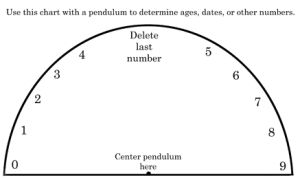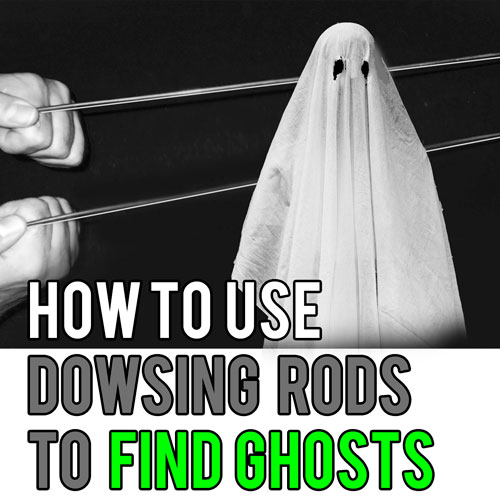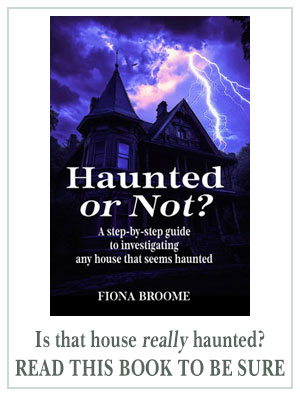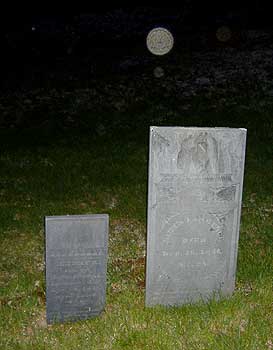This article is strictly for professional ghost hunters. If you haven’t researched at 20+ haunted sites, do NOT experiment with pendulums, or any divinatory tools.
What is a pendulum?
In popular use, a pendulum usually refers to any weighted object that can swing back and forth.
 You’ve probably seen pendulums (or pendula) on old clocks. The pendulum is the round thing below the face of the clock, and the pendulum swings back and forth, rhythmically, keeping time.
You’ve probably seen pendulums (or pendula) on old clocks. The pendulum is the round thing below the face of the clock, and the pendulum swings back and forth, rhythmically, keeping time.
If you pause the pendulum, the clock stops working.
In ghost hunting, a pendulum is usually a small, heavy object – like a stone, a crystal, or even a piece of metal – suspended from a cord, ribbon, or chain.
A necklace – one you regularly wear – can be ideal for this. (After all, when you’re investigating a haunted site, it’s smart to carry only the most essential, dedicated ghost hunting equipment. A necklace is one less item to pack in your ghost research kit.)
Some pendulums are highly decorative. Some of them have been blessed. Each one is unique and will respond differently.
A person – perhaps a psychic or a medium – holds the cord, ribbon, or chain so the heavy object can swing freely. Then, that person asks a question.
Or someone else in the room may ask the question. Sometimes this works. Sometimes it doesn’t.
The movement of the pendulum determines the answer.
How to Use a Pendulum
The end of the string is held between the forefinger and thumb so that the object can swing freely. You can pinch the cord or chain at the very top, with your hand at an angle so your fingers are out of the way.
Or, you can drape the cord or chain over the middle of your index finger, and keep it from slipping by applying gentle pressure from your thumb onto the cord or chain, against your finger.

 If you’d just like to experiment with this, you can make your own pendulum by tying any heavy bead or small pendant to a string or cord. The string should be about ten inches long.
If you’d just like to experiment with this, you can make your own pendulum by tying any heavy bead or small pendant to a string or cord. The string should be about ten inches long.
You should be able to decide if pendulums work for you (they won’t work well for everyone) and if you like them.
The Best Way to Use a Pendulum
Some people are naturally gifted at pendulum use.
That seems to have no connection with whether they’re believers or skeptics.
When trying to communicate with a ghost, they just hold the pendulum at the top of the chain (or cord, or ribbon) and wait for the weighted end – the fob or bob or “weight-stone” – to move.
They’re waiting for something external to move it.
If the bob moves, great. If it doesn’t, maybe the site isn’t haunted. Or the ghost (or ghosts) have nothing to say.
Either way, the person holding the pendulum remains objective and somewhat mentally detached. To them, it’s like asking any stranger a question: Maybe the stranger replies. Maybe they don’t.
But… Don’t Ask Spirits to Talk “Through You”
Sometimes, a person might use a pendulum, but they internalize the energy.
That is, they ask the spirit to speak through them.
(For example, in a haunted setting, the person may ask the ghost to use the investigator’s hand to channel the energy to the pendulum.)
That’s not a good idea. In fact, it can be downright dangerous. (Basically, you’re asking for a spirit – good or evil – to take possession of your body. This can be just as risky as using a Ouija board.)
THIS IS IMPORTANT: If you can’t remain completely separate – mentally, spiritually, and emotionally – from the pendulum you’re using, stop immediately.
Never allow outside energy to be channeled through your body to the pendulum. (And, if you can’t tell the difference, don’t use a pendulum. The risks are too great.)
If you decide that a pendulum is right for you, I recommend professionally crafted pendulums. You’re likely to get better results.
However, try a homemade pendulum or two, before investing in a professional-grade pendulum.
Baseline Every Time
If you’re using a pendulum regularly – especially in haunted locations – start with some baseline readings.
It’s important to verify these every time you use the pendulum.
First, hold the pendulum entirely still. (It’s okay to steady it with your other hand, and then release it.)
Then ask a question with a yes or no answer that you already know.
Note the way that the pendulum swings in response. It may swing from side to side or from front to back. Or, it may swing in a clockwise or counter-clockwise manner.
Now, ask another question with a different yes or no answer, that you already know. Compare the results.
Repeat this several times until a clear pattern is established. (If no pattern emerges, you may need to use other divinatory tools. Pendulums don’t work for everyone, and it has no bearing on the person’s psychic abilities.)
What to Ask in Haunted Places
In haunted sites, you can start by asking, “Is this room (or battlefield, or cemetery) haunted?” or a similar question.
However, if the ghosts think they’re still alive – or otherwise rejects the “haunted” idea – you may need to start with a question like, “Is a stranger present?” (Whether the ghost thinks you’re the “stranger” or they are, the answer should be yes.)
Then you can ask how many spirits are present, or how old the ghost his, and so on.
The more active the pendulum movement, the stronger the spiritual energy is at that site.
Even in the hands of a skeptic, I’ve seen a pendulum swing so wildly, the weight snapped off a new chain and flew across the room.
In other words, pendulums can be very powerful.
Free Pendulum Charts
I’ve created two different charts for use with your pendulum. Visit my author website, FionaBroome.com, and go to my Free Downloads page.
Scroll down to the Misc Printable Charts section. Download the pendulum charts and print them. (They’re free PDFs.)
To use either chart, hold the string so that the tip of the pendulum is about two inches above the center “dot” at the bottom of the half-circle. Then, ask your question.
One chart is designed for simple, yes/no questions. You can draw this on a sheet of paper, and use it yourself. The pendulum should favor one direction/answer more than any other. If it doesn’t rephrase your question, or take a break and return to this later.
 The next kind of chart can be used to ask anything with numbers, such as the ghosts age when he or she left physical form. (Or, if the ghost believes that he or she is still alive, ask what year it is now.)
The next kind of chart can be used to ask anything with numbers, such as the ghosts age when he or she left physical form. (Or, if the ghost believes that he or she is still alive, ask what year it is now.)

You can create your own charts on paper, providing many other kinds of answers, too. They could include letters of the alphabet, people’s names, places, or things specific to the life of the ghost you’re contacting.
When the Pendulum Swings the Wrong Way
No matter which chart you use, if the pendulum swings towards you, off the chart, try rephrasing your question. Or, the ghost may want you to answer the question for yourself, first, and then have spirit confirm it with a yes or a no.
If you are adept with a pendulum, I recommend professional pendulums designed for ghost hunters and psychic mediums, such as those from Sean Paradis. (I’m not sure he’s still making pendulums, but his are still among the ones I trust the most.)
Homemade Pendulums or Purchased Pendulums?
If you’re shopping for a pendulum, try it in the store. See how it works for you.
Compare each with your homemade pendulum(s).
If you did just as well (or better) with your own, keep using it. There’s no reason to buy one, unless it seems more powerful or attractive.
I own several pendulums, and choose them intuitively for the location and the energy at it.
 Sometimes, I like the conductivity of a copper pendulum. (Some people believe the metal helps spirits make contact with the pendulum.)
Sometimes, I like the conductivity of a copper pendulum. (Some people believe the metal helps spirits make contact with the pendulum.)
Other spirits seem attracted to pretty colors. So, a colorful pendulum with an “ooh, shiny!” attraction might get better results.
Whichever pendulum you use, it should be one that seems attractive to you, too.
You Can Ghost Hunt Without Tools
Some people achieve remarkable results with pendulums.
Others don’t.
Some have a knack for recording EVP, but never get great ghost photos. And vice versa.
It’s not a measure of how good you are at ghost hunting or communicating with spirits.
It’s more like singing or running… different people have different talents. Someone who can play the violin may be perfectly awful at the piano.
However, one of the great things about pendulums, besides their simplicity, is: You can try this on your own without spending a cent.
And then, if pendulums work for you, decide which seem to work best. (I’ve linked to a couple of my favorites, below.)
But really, if a homemade pendulum works well for you, keep using it, at least until you know if it’s a tool you’ll use regularly
 1.) Use two thin wire coat hangers. (Some people use just one dowsing rod for their investigations. I’ve tried that, and prefer to use two. I think they provide more accuracy and clearer results.)
1.) Use two thin wire coat hangers. (Some people use just one dowsing rod for their investigations. I’ve tried that, and prefer to use two. I think they provide more accuracy and clearer results.)


 You’ve probably seen pendulums (or pendula) on old clocks. The pendulum is the round thing below the face of the clock, and the pendulum swings back and forth, rhythmically, keeping time.
You’ve probably seen pendulums (or pendula) on old clocks. The pendulum is the round thing below the face of the clock, and the pendulum swings back and forth, rhythmically, keeping time. If you’d just like to experiment with this, you can make your own pendulum by tying any heavy bead or small pendant to a string or cord. The string should be about ten inches long.
If you’d just like to experiment with this, you can make your own pendulum by tying any heavy bead or small pendant to a string or cord. The string should be about ten inches long.




 When our ghost hunting team arrived, I placed the compass on top of Hannah Robbins’ headstone at the northern end of the cemetery.
When our ghost hunting team arrived, I placed the compass on top of Hannah Robbins’ headstone at the northern end of the cemetery.